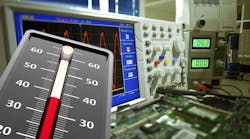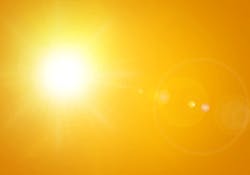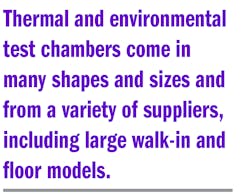Taking temperature is a good way to check on health, whether for a patient or a device under test (DUT). Making measurements on a DUT at RF/microwave frequencies and at different ambient temperatures can provide evidence on how well the device or component will do under “real world” conditions, especially if it is intended for outdoor use. And maintaining a DUT under different operating temperatures requires a seldom-used-but-invaluable measurement accessory—an environmental chamber.
While such chambers can be rented as needed, they often demonstrate their value to a test bench after a short time, for the multitude of different measurement scenarios that they support. These including design verification testing, performance calibration tests, telecommunications equipment characterization over wide operating temperature ranges, and accelerated lifetime testing. Some application areas in particular—such as automotive and military electronics components and modules—require extensive thermal characterization to ensure consistent and dependable performance over all the operating temperatures expected during normal use.
Thermal and environmental test chambers come in many shapes and sizes and from a variety of suppliers, including large walk-in and floor models. There are also much smaller benchtop models, and even portable units that can be easily moved from place to place as needed for thermal testing. Choosing an environmental test chamber for an application or group of applications will be determined by the size and type of DUT that must be tested, the temperature range over which the test chamber must operate, and additional functionality that might be needed as part of the environmental testing.
For example, many thermal chambers also provide control over relative humidity (RH). In addition, environmental chambers of various sizes are available over many different operating temperature ranges. Some only have positive temperature ranges (e.g., +5 to +94°C); others have negative and positive temperature ranges (e.g., −65 to +180°C); and still others have extremely wide operating temperature ranges (e.g., −65 to +300°C), as might be needed in on-wafer semiconductor testing and failure analysis.
Some environmental test chambers are also equipped to perform thermal shock testing, and support a full range of MIL-STD-883 testing for characterizing DUTs according to military and aerospace requirements.
Temperature cycling involves programming hot, cold, and ambient temperatures covering a total temperature range, and the times for which the chamber remains at the ambient temperature and the temperature extremes. Device and component measurements performed during the product development stage, such as with an RF/microwave vector network analyzer (VNA), must be coordinated during this time and synchronized so that test results are collected at desired temperatures or in required steps across a temperature range for further analysis.
High-frequency measurements in an environmental chamber intended as part of production-line testing will usually be automated and under software control for the greatest efficiency and repeatability in maintaining synchronization between the test equipment and the environmental chamber.
Environmental chambers represent a major workplace investment, but a worthwhile one—especially when the same environmental chamber can also be used for production testing. The necessary size of the chamber will be determined by the size of the DUT or expected future DUTs, while the temperature range will be set by the expected applications for a product line.
Along with providing the capability to qualify an electronic product under its actual expected environmental conditions, an environmental test chamber can contribute a great deal of insight into measurements performed on a design during the research-and-development (R&D) stage, and can quickly become one of those invaluable “accessories” on the test bench.



